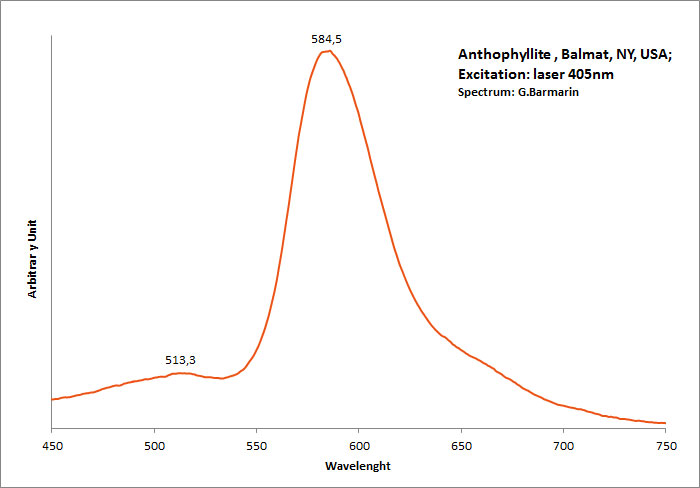Base de données des minéraux luminescents
ANTHOPHYLLITE
Formule chimique: XMg7Si8O22(OH)2
Famille: Silicates
Statut: IMA-A (GP)
Système cristallin : Orthorhombique
Minéral de vitrine: NON
Luminescence:
Couleurs UV longs (365nm): |
Rose violacé , | ||
Intensité OL:Forte | |||
Couleurs UV moyens (320nm): |
Rose violacé , | ||
Couleurs UV courts (254nm): |
Rose violacé , | ||
Intensité OC:Forte | |||
Photo Ondes Courtes (254nm)

Anthophyllite SW
Balmat Mine, Sylvia Lake, Fowler, St. Lawrence Co., New York, USA;
Photo & Col. © G. Barmarin
Vous avez une photo de ce minéral que vous voudriez voir figurer dans la galerie? Contactez-nous!
Phosphorescence (au sens commun du terme) observable à l'oeil nu:
Pas de données
Commentaires:
Material labelled tirodite from the International Talc Company mine, Talcville, New York, USA (Segeler, 1961), has been shown to be manganocummingtonite by electron microprobe (by Mike Hawkins, curator at the NY State Museum mineral collection). See further discussions at: http://www.mindat.org/mesg-7-206424.html Additional material labeled tirodite from the International Talc Company mine, Talcville, New York, USA, was confirmed to be anthophyllite by XRD performed by John Attard on a sample submitted by John Duck in April, 2012. Accordingly, without confirmation, the identity of similar material may be either manganocummingtonite or anthophyllite. Visual identification or identification by fluorescent response is not possible.
Activateur(s) et spectre(s):
Activateur(s): Mn2+ ,
Pics dans le spectre (nm):
band with a peak at 398nm, 513, 585nm Mn2+ repl. Mg2+ : band peaking at 651-655 nm

Anthophyllite, Balmat, NY, USA.
Excitation: laser 405nm. Col. G. Barmarin; Spectre: G. Barmarin
Commentaires sur les spectres et les activateurs (*):
The photoluminescence spectra, optical excitation spectra and PL decay curves of anthophyllite from Canada were obtained at 300 and 10 K by Aierken Sidike and Al.. The MnO content in the sample, determined using an electron probe microanalyzer, was high at 5.77 wt%. In the photoluminescence spectra obtained under 410nm excitation, bright red bands with peaks at 651 and 659nm were observed at 300 and 10 K, respectively. The origin of the red luminescence was ascribed to Mn2+ in anthophyllite from the analysis of the excitation spectra and photoluminescence decay times of 6,1–6,6 ms. In the PL spectra obtained under 240nm excitation at 300 K, a small violet band with a peak at 398 nm was observed. On the violet band at 10 K, a vibronic structure was observed. The origin of the violet luminescence was attributed to a minor impurity in anthophyllite.
(Source: Photoluminescence properties of anthophyllite, Aierken Sidike, Nuerrula Jilili, S. Kobayashi, K. Atobe and Nobuhiko Yamashita, Physics and Chemistry of Minerals, vol37 , 2009)
(*)Les commentaires sur les spectres sont uniquement rédigés en Anglais
Meilleure(s) localité(s) pour la fluorescence (*):
- International Talc Company Mine (Reynolds Mine), Talcville, St. Lawrence Co., New York, USA;
- Balmat Mine, Sylvia Lake, Fowler, St. Lawrence Co., New York, USA;
(*)Les données ne sont pas exhaustives et sont limitées à quelques localités remarquables pour la fluorescence
Référence bibliographique pour la luminescence:
- The Henkel Glossary of Fluorescent Minerals, Dr. Gerhard Henkel, Published by the FMS, 1989 ,
- Fluorescence: Gems and Minerals Under Ultraviolet Light, Manuel Robbins, 1994, Geoscience Press, ISBN 0-945005-13-X ,
- The World of Fluorescent Minerals, Stuart Schneider, Schiffer Publishing, 2006, ISBN 0-7643-2544-2 ,
- Luminescent Spectra of Minerals, Boris S. Gorobets and Alexandre A. Rogojine, Moscow, 2002 ,
Référence pour la luminescence sur internet:
Images:
- Talcville, New York, USA: http://www.mindat.org/photo-278698.html
- Talcville, New York, USA: http://www.mindat.org/photo-278693.html
- Nature s Rainbow
Référence minéralogique sur internet:
 http://www.mindat.org/show.php?name=Anthophyllite
http://www.mindat.org/show.php?name=Anthophyllite
 http://webmineral.com/data/Anthophyllite.shtml
http://webmineral.com/data/Anthophyllite.shtml
Recherche sur Internet:
 Recherche d'images sur 'Google Image'
Recherche d'images sur 'Google Image'
 Recherche de documents en français sur Google
Recherche de documents en français sur Google
 Recherche de documents en toutes
langues sur Google
Recherche de documents en toutes
langues sur Google
Une requête ne donnant pas de résultat signifie uniquement qu'aucune référence de ce type n'existe dans la base mais en aucun cas qu'elle n'existe pas dans l'absolu. Si vous considérez avoir trouvé une erreur ou une omission, merci de nous le signaler via la page contact en n'oubliant pas de citer la source de l'information.
